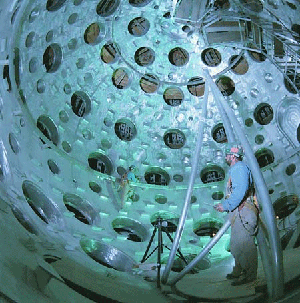Apr
15
The Boron-11 Hydrogen Fueled Fusion Looks Better Than Thought
April 15, 2011 | 4 Comments

Animated Boron-11 Hydrogen Fusion Graphic Image File. Image Credit: The Focus Fusion Society. Click image for the largest view.
This news will increase the amount of energy that would be recovered should a fusion reactor develop to exploit the energy release.
Duke nuclear physicist Henry Weller, a co-author of the new study said, “Obviously, a detailed understanding of the energy and location of every outgoing alpha particle is crucial to the development of this reactor.” Research drives on from the belief that one or more of the fusion reactor research efforts will need to collect the reaction products and generate electricity. That gets more likely as the ability to recover the fusion products and increased yield gets better.
The TUNL researchers have been developing reactors to slam hydrogen at high speeds into boron-11, a collision that yields high-energy helium nuclei, or alpha particles. Those alphas then spiral through a tunnel of electromagnetic coils, transforming them into a flow of electrons, or electricity. Knowing what alphas and where they are going is of critical importance.
Weller and his colleagues took a fresh look at the hydrogen-boron fusion event. They expected to confirm the accepted wisdom that a collision of one hydrogen particle and one boron-11 particle produces a single high-energy alpha particle – which produces electricity quite well – and two lower energy alphas, which are less useful for generating electricity.
But explains Duke nuclear physicist and study co-author Mohammad Ahmed, the team found the collision yields not one, but two high-energy alphas, which shoot off at an angle of 155 degrees, along with the one lower-energy alpha. The existence of this second high-energy alpha could mean the new types of fusion systems could be able to produce much more electricity than expected.
There is a long history in the Boron-11 Hydrogen fusion. In 1936 physicists M.L.E. Oliphant and Lord Rutherford at Cavendish Laboratory in Cambridge, England made crude, but apparently correct, estimates of the two higher-energy alphas. The unexpected TUNL finding appears to confirm a long-forgotten observation. Scientific replication can take a very long time – in this field some 75 years.
Since that time there have been numerous theoretical and experimental studies of this reaction at these and higher energies continuing to the present time.
The new Duke and TUNL results appear online in Physics Letters B, while the pdf has already escaped onto the Internet and can be downloaded from Duke University.
The team measured the α-particle singles and coincidence spectra and angular distributions for the 11B(p,α)αα reaction at two different resonance energies and compared the measurements with simulations finding that the two-step sequential model with l = 1 primary α-particles describes the data at the 2.64 MeV 3− resonance quite well, but that l = 3 primary α-particles are required to describe the data at the 0.675 MeV 2− state as originally discovered by J. Quebert, L. Marquez, Nuclear Physics A 126 646 in 1969.
The paper confirms the l = 3 assumption predicts the existence of two high energy α-particles at an opening angle centered at 155º – as originally proposed by Dee and Gilbert.
This means that the astrophysical rates for the 11B(p,α)αα reaction must be revised upward. Its also going to have considerable effect across the fusion development community from the Nebel led Bussard fusion group, Eric Lerner’s Focus Fusion where the earliest notations about the new study came up and on the quiet TriAlpha Energy using the Rostocker method.
Its worth noting that part of the funding for this research came from a US Department of Energy grant number DEFG02-97ER41033 and Tri Alpha Energy Incorporated itself who has strong motivations to get accurate numbers.
In the coming weeks the calculations will complete to show just how much more electricity could be collected. It’s not straight linear arithmetic. Yet trading out one low energy alpha for a high energy one is going to help. Actually the new numbers will really increase the motivation to get to breakeven and beyond and increase interest for commercial development.
Another certain science conclusion bites the dust.
Comments
4 Comments so far



Hydrogen Boron fusion actually creates electricty directly – as well as heat. That eliminates the need for a large turbine facility.
Large, high temperature nuclear reactors are likely to never make economic sense in light of Dr. Rossi’s energy catalyzer which produces 7 horsepower of heat in a 50cc container (about 1/4 cup). For more details see: wikipedia entry “energy catalyzer” or nickelpower.org.
Very interesting, but the future of energy is here already (or very near to it) in the form of Thorium Molten Salt Florine Reactors. Look up Kirk Sorensen on youtube or wikipedia and prepare to be amazed and pissed off that we haven’t already fully developed this concept.
Also interesting in this field is the Lockheed Martin “Skunkworks” announcement this year of a functional 100MW fusion reactor the size of a tractor trailer. According to the article they expect to be able to field models in 10 years.
I think the Thorium work shows great promise. Rossi’s work is still under investigation. He hasn’t actually produced a working, reproducible theory of WHY his devices show excess heat generation, and evidently his demonstrations are hit or miss. He’s definitely got something there, but we’re not REALLY sure what yet.
Follow me on Twitter @VAXHeadroom